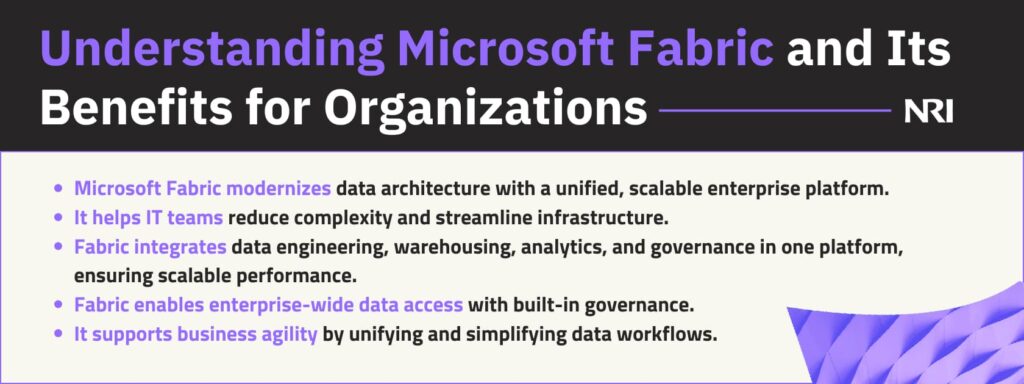Leverage Microsoft Fabric to simplify technology stacks, drive cross-functional collaboration, and future-proof your data strategy.

In recent years, enterprises have experienced exponential growth in their data volume, variety, and velocity. As they accelerate digital transformation initiatives, the complexity of their ecosystems has increased, creating significant challenges in extracting value from data assets.
Historically, many rely on a patchwork of specialized tools to address different aspects of their data needs. This fragmentation creates operational inefficiencies, increased costs, and hinders the ability to derive cohesive insights. Data is siloed across disjointed systems, spreadsheets, and databases, making it tedious to store and analyze effectively. And managing complex integrations between these disparate systems often results in data inconsistencies and governance challenges.
IT professionals and decision makers need solutions that address today’s and tomorrow’s technical, security, and governance requirements. Microsoft Fabric allows you to become a more agile, data-driven organization. Read on to learn more.
What is Microsoft Fabric?
Microsoft Fabric is a comprehensive “data operating system” for modern enterprises that supports the entire analytics lifecycle from raw data ingestion to AI-powered insights. It unifies the capabilities of Power BI, Data Factory, Synapse, and other previously separate services, allowing them to work together as a cohesive unit. This integration eliminates the traditional boundaries between data management functions, creating smooth transitions between data engineering, data science, real-time analytics, and business intelligence.
At the heart of Fabric is OneLake, a central storage layer that allows you to retrieve data from various platforms. OneLake is within your Fabric tenant, where you can land, process, and save your data in desired formats, such as Delta tables in your Lakehouse.
The fundamental concept behind OneLake is to maintain a single copy of data throughout your organization, thereby avoiding unnecessary duplication and movement. This approach simplifies data management and ensures consistency across your different analytical workloads. Furthermore, the open-source nature of the Delta Lake format facilitates integration with other products that can read from a Delta Lake, enhancing interoperability with your existing systems.
Core Capabilities and Architecture
End-to-End Data Lifecycle Support: Ingestion to Insights
Microsoft Fabric supports the complete data lifecycle, from initial ingestion to actionable insights. Its data lakehouse architecture consists of five layers that work together seamlessly to create a consistent foundation for downstream analysis:
- Ingestion: Facilitates the collection of data from various sources
- Storage: Provides a centralized repository for all data assets
- Metadata: Manages information about the data for enhanced discoverability
- API: Enables programmatic access to the platform’s capabilities
- Consumption: Supports various analytical workloads and visualization needs
Fabric’s end-to-end integration eliminates the typical handoffs and friction points between data pipeline stages, enhancing reliability and time to insight.
Built-in Security, Governance, and Compliance Tools
Microsoft Fabric incorporates robust identity and access management, data encryption, and compliance management capabilities to protect sensitive information throughout its lifecycle. Its unified approach to governance allows your organization to implement consistent policies across the entire data estate, avoiding the security gaps that often emerge at integration points between disparate systems. This simplifies regulatory compliance while providing the flexibility to adapt to evolving requirements.
SaaS Model and Interoperability with the Microsoft Ecosystem
As a cloud-native software-as-a-Service (SaaS) offering, Fabric provides automatic scaling, continuous updates, and built-in resilience. It also deeply integrates with the broader Microsoft ecosystem, including Microsoft 365, Azure services, and other business applications. This interoperability extends the platform’s value by connecting data insights to business processes and provides a familiar environment for users already working with Microsoft technologies.
Strategic Benefits for IT Teams
Reduced Infrastructure Overhead and Operational Complexity
One of Microsoft Fabric’s primary advantages is that it eliminates the burden of managing complex, heterogeneous data environments, thereby slashing operational costs. Consolidation means fewer systems need to be maintained and supported. Further, Fabric’s SaaS delivery model eliminates infrastructure management tasks like capacity planning, patching, and upgrade coordination, freeing IT resources for more strategic initiatives.
Accelerated Deployment and Time-to-Value
Fabric’s pre-integrated nature eliminates lengthy integration projects, allowing your enterprise to deploy comprehensive data capabilities in days, not months. This rapid implementation extends to new functionalities, with capabilities readily available through the unified interface rather than requiring separate procurement and deployment cycles. So now, with Fabric, you can swiftly respond to new business requirements while optimizing resource use.
Enhanced Data Governance and Scalability
With Fabric, you can establish a consistent governance framework across all workloads. The platform’s unified architecture allows you to implement policies once and automatically enforce them throughout the data lifecycle, reducing compliance risk. Plus, its cloud-native design improves scalability—you can support fluctuating demands and expanding data volumes without compromising performance or requiring complex capacity planning.
Empowerment of Business Users Through Self-Service Analytics
Microsoft Fabric’s intuitive interface empowers business users to explore data, create visualizations, and generate insights independently while working within governance guardrails established by IT. This self-service capability reduces the request backlog for IT departments, making business users feel more independent and capable.
Enabling the Future of Data-Driven IT
Supporting AI and advanced analytics at scale
The ability to support next-generation AI and advanced analytics workloads at scale will define competitive advantage now and in the years ahead. Fabric’s unified data foundation creates ideal conditions for machine learning by combining diverse data sources and providing the scale necessary for practical model training. As generative AI and other advanced techniques evolve, Fabric provides a future-ready foundation that can adapt to emerging requirements without wholesale replacement of existing systems.
Aligning IT and Business Through Unified Data Strategy
Encourage collaboration between the IT and business teams to foster a shared understanding and joint ownership of the initiative. A unified strategy mapping technical capabilities to business requirements will ensure you maximize the value of your Microsoft Fabric investment.
Roadmap for Adoption and Integration into Existing Environments
- Plan: Assess current data setup, define goals, and get leadership buy-in.
- Govern: Set clear data ownership and governance policies aligned with business needs.
- Implement: Prepare infrastructure and ensure licensing.
- Enable Users: Train users, build communities, and provide support.
- Deploy and Improve: Roll out in phases, monitor progress, and evolve maturity.
Get Started with Microsoft Fabric
Microsoft Fabric is your opportunity to bring order to the chaos of managing data across different environments. As a leading Microsoft Solutions partner, NRI can guide your organization through adopting Fabric to maximize the value of your technology investment.
Get in touch now to learn more about how Fabric can elevate your business and IT.



